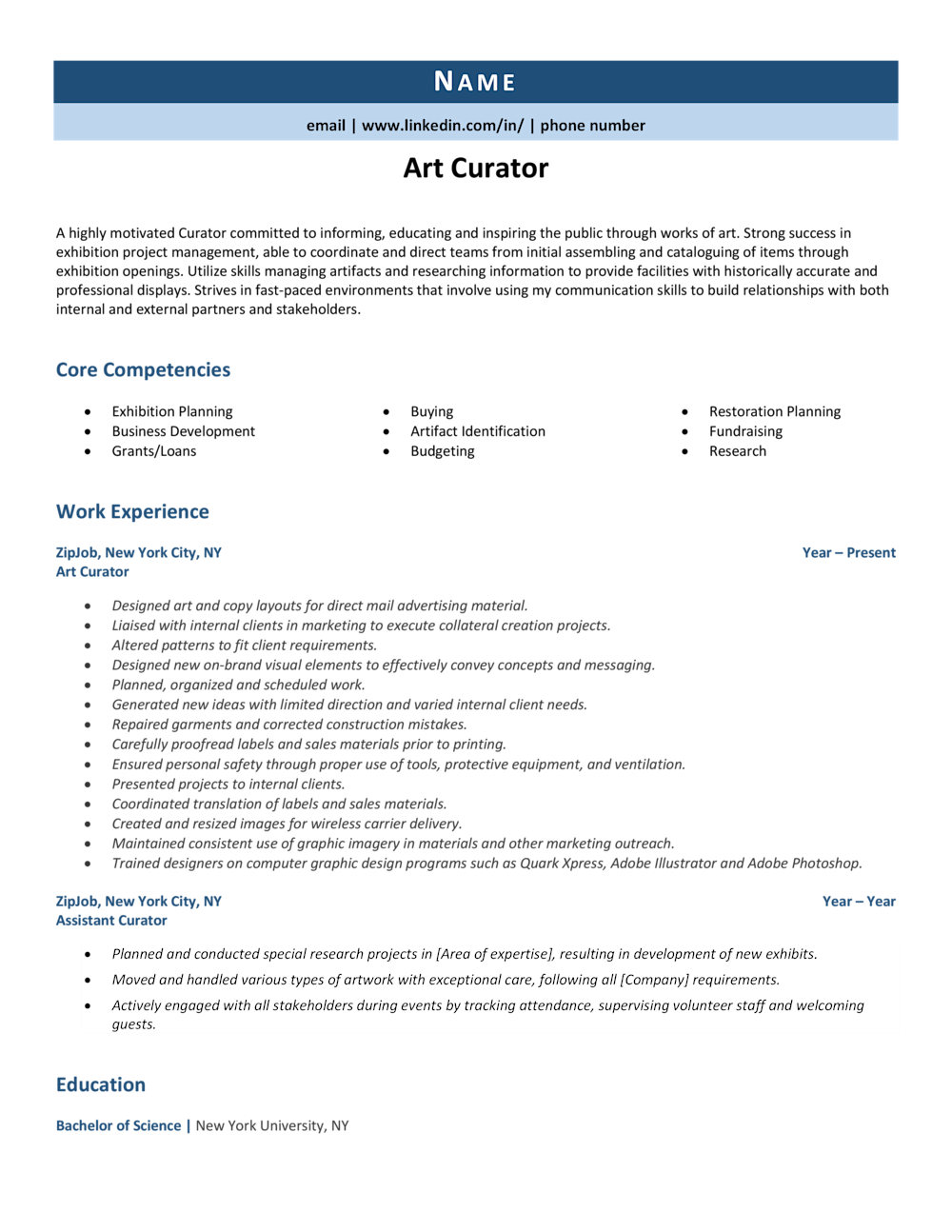Art Curator Sample
Download and customize our resume template to land more interviews. Review our writing tips to learn everything you need to know for putting together the perfect resume.
Art curators are expected to be in high demand throughout the next decade, with overall employment projected to enjoy 10% growth through 2032. If you’re on the path to a successful career in this field, you’ll need a powerful and compelling Art Curator resume to help you open doors to new opportunities and career advancement. You already know how to manage the creative aspects of a museum or art gallery – but curating the right information to create that convincing resume poses a different kind of challenge.
To help you select, organize, and present those resume-enhancing details, we’ve created this Art Curator resume guide, filled with the vital tips and tricks you need to craft a great resume. These tips will include essential advice to help you format and structure your resume, along with keen insight into the type of information today’s employers expect to see in your job search documents. We’ll also provide a helpful resume example that you can use as a visual guide.
How to write a resume
Before you get started with the information curation part of your resume crafting process, there are a few fundamentals that we need to cover. By getting the basic principles down first, you can simplify this process and ensure you’re designing a resume with a firm foundation. As you’re constructing your resume, make sure that you choose the right format and structure, focus on relevant information about your skills and achievements, and pay attention to the details that can make or break any resume submission.
Format and structure
Everything starts with the format you choose and the way in which you structure your document. As far as format is concerned, there are three options: the reverse-chronological, the functional, and the combination. Experienced Art Curators will be best served by the reverse-chronological format, which simply lists your work experience in reverse chronological order, starting with your current position. This is the option that most hiring managers really want to see.
Once you’ve made that decision, the next step is to outline your resume using a clean and simple structure. Resumes are not like other documents, of course. Instead of using a solid wall of text, you should divide similar types of information into separate sections. That way, hiring managers can easily skim the sections they’re interested in. Below is a common structure that you should consider using.
Contact information: At the top of your resume, add your name, location, and contact details like a working phone number, email, and LinkedIn URL.
Title: This is the headline for your resume. It should contain the job title you’re seeking, as well as a few words that add some zest to your title. For example, Dynamic Art Curator with 8 Years of Experience in Exhibition Design.
Summary statement: Your summary is a short paragraph of three to five sentences that is effectively your resume’s elevator pitch. Include your most relevant skills and experience, as well as a notable achievement that might attract the employer’s interest.
Core competencies: This is your skills section and should include both hard and soft skills. We’ll go into more detail on this section later in the guide.
Professional experience: Your work history needs to be listed in reverse chronological order. For each job you list, include the company name, your job title, the dates you were employed, and a few bullet point highlights demonstrating measurable achievements.
Education: Here, you should add information about the college you attended and your course of study. You can also add any certifications or additional training that you’ve acquired.
Tailor your resume for relevancy
The resume you create should be considered a base document that you need to revise for each job you seek. That means tailoring it to include specific keywords from the job posting to ensure that your skills, experiences, and achievements align with the required qualifications. As you make these changes, focus on relevancy and ask yourself whether the information you are including will be something that the employer will want to see.
Mind the details
Sometimes, it’s the small things that become the biggest obstacles. Before you submit your resume, make sure that you give ample attention to details like proofreading. Even a small mistake in your resume could negatively impact your chance of impressing an employer. Those seemingly small details include proofreading for spelling and grammatical errors, verifying every piece of information you include in your document, and focusing on ensuring that your achievements demonstrate your ability to add value to the position.
Art Curator resume example
While tips and recommendations are helpful, there are times when a visual example can really drive the message home. That’s why we’ve included the Art Curator resume example below: so that you can study it to see exactly how these tips are used to create a resume that convincingly conveys vital skills, experiences, and professional accomplishments.
As you examine this sample resume, pay careful attention to essential sections like the summary and work experience. Those key sections focus on showcasing how to use core competencies to create value for employers. Remember to utilize that same value-based approach in your own Art Curator resume.
Name
Title
City, State or Country if international
Phone | Email
LinkedIn URL
ART CURATOR PROFESSIONAL
A highly motivated Curator committed to informing, educating and inspiring the public through works of art. Strong success in exhibition project management, able to coordinate and direct teams from initial assembling and cataloguing of items through exhibition openings. Utilize skills managing artifacts and researching information to provide facilities with historically accurate and professional displays. Strives in fast-paced environments that involve using my communication skills to build relationships with both internal and external partners and stakeholders.
CORE COMPETENCIES
Exhibition Planning
Business Development
Grants/Loans
Buying
Artifact Identification
Budgeting
Restoration Planning
Fundraising
Research
PROFESSIONAL EXPERIENCE
Art Curator
ZipJob, New York NY | Year to Year
Responsibilities
Designed art and copy layouts for direct mail advertising material.
Liaised with internal clients in marketing to execute collateral creation projects.
Altered patterns to fit client requirements.
Designed new on-brand visual elements to effectively convey concepts and messaging.
Planned, organized and scheduled work.
Generated new ideas with limited direction and varied internal client needs.
Repaired garments and corrected construction mistakes.
Carefully proofread labels and sales materials prior to printing.
Ensured personal safety through proper use of tools, protective equipment, and ventilation.
Presented projects to internal clients.
Coordinated translation of labels and sales materials.
Created and resized images for wireless carrier delivery.
Maintained consistent use of graphic imagery in materials and other marketing outreach.
Trained designers on computer graphic design programs such as Quark Xpress, Adobe Illustrator and Adobe Photoshop.
Assistant Curator
ZipJob, New York NY | Year to Year
Responsibilities
Planned and conducted special research projects in [Area of expertise], resulting in development of new exhibits.
Moved and handled various types of artwork with exceptional care, following all [Company] requirements.
Actively engaged with all stakeholders during events by tracking attendance, supervising volunteer staff and welcoming guests.
EDUCATION
Complete School Name, City, St/Country: List Graduation Years If Within the Last Ten Years
Complete Degree Name (Candidate) – Major (GPA: List if over 3.3)
Relevant Coursework: List coursework taken (even include those you are planning on taking)
Awards/Honors: List any awards, honors or big achievements
Clubs/Activities: List clubs and activities in which you participated
Relevant Projects: List 2-3 projects you have worked on
Key hard & soft skills for an Art Curator
As an Art Curator, you rely on your knowledge of art and its history, your keen sense of design and organization, and technical skills that enable you to manage art collections, utilize digital technology, and deal with budgetary and funding concerns. Those hard skills are accompanied by an array of critical soft skills that help you deal with artists, other venues, vendors, patrons, and colleagues.
These hard and soft skills need to be properly conveyed in your resume so that employers can understand your talents and abilities. Below, we have listed some of the most common Art Curator skills that you may choose to include in your core competencies section. Compare your skills to those listed in the job posting and use terms that match the position's required qualifications. That will help you ensure that your resume includes the keywords necessary to pass any applicant tracking system (ATS).
Essential hard skills for an Art Curator resume
Hard skills are sometimes referred to as technical skills and include key job-related and transferable abilities that you need to perform your job. Typically, these skills are learned and developed in formal education settings, via certification programs, or through experience and hands-on training. Below, we have compiled a list of seven of the most common abilities curators like you often include in their resume’s core competencies section:
Art history knowledge
Collection management
Digital preservation
Budgeting
Grant writing
Cataloging
Exhibition design
Critical soft skills for an Art Curator resume
Of course, there’s more to the job than just those technical skills. You also need an array of soft skills to enable you to employ those hard skills, lead teams, and deal with colleagues and clients. We’ve assembled a list of some commonly cited soft skills below, including important abilities like:
Creativity
Communication
Organization
Problem-solving
Meticulous attention to detail
Leadership
Critical thinking
Summary & last words
Writing a truly compelling resume is one of the most important things you can do to supercharge your career. Your Art Curator resume needs to serve as your main marketing tool, effectively showcasing everything that you have to offer to a prospective employer. With the tips, recommendations, and sample resume included in this guide, you now have all the basic tools you need to create a resume that conveys your skills, experiences, and achievements to the employers who need to see them.
Introduction to ZipJob: Professional resume writers
However, if you really want to take your Art Curator resume to the next level of professionalism, you may want to consider partnering with professional resume writers. That’s where we enter the picture! The ZipJob team of expert writers has the experience and industry knowledge you need to ensure that your resume leaves a lasting impression on any employer. Reach out to us today to learn more about how we can help you develop the job search tools you need for career success.
Why you should make use of our resume writing services to land your next job as an Art Curator
Given the important role your Art Curator resume plays in your job search strategy, it is critical to choose the right partner to help you craft that document. At ZipJob, our team is comprised of experienced professionals who are committed to providing you with a truly personalized resume that can help you land more interviews. We work with you to ensure that your resume delivers one message loud and clear: you’re the best possible person for the job!
Resume writing service for Art Curator: Let us write your resume
By partnering with our accomplished resume writing team, you can rest assured that your final resume product will set you apart from every other candidate out there. You’ll be able to proudly submit an Art Curator application that compellingly sells your skills, achievements, and experiences in a way that inspires employers to call you with interview requests and job offers. Contact us today to learn more about how our team can help you enjoy greater job search and career success than ever before.



